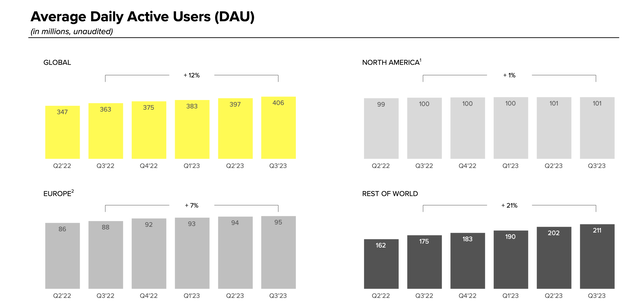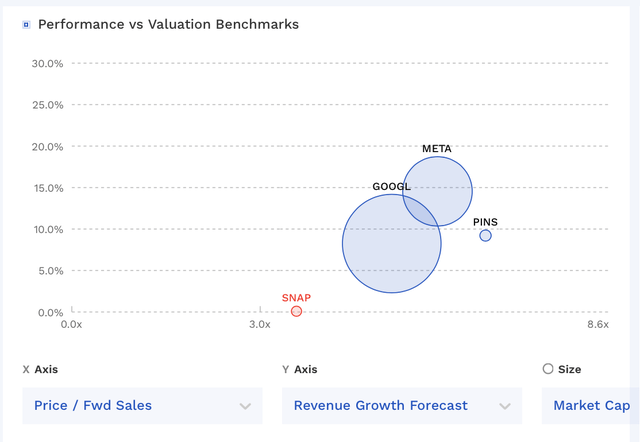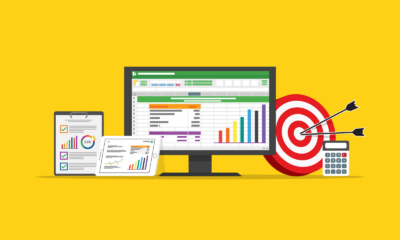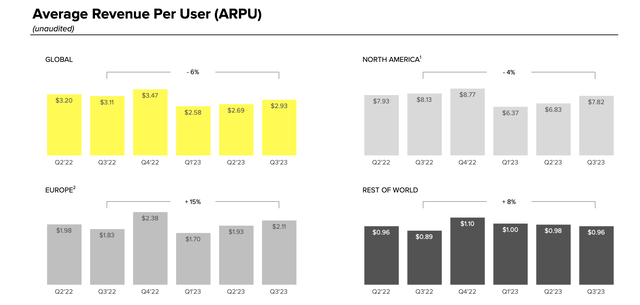SOCIAL
Snap: Downgrading To ‘Hold’ As Turnaround Has Been Slow (NYSE:SNAP)

stockcam
Back in March, I said that while Snap (NYSE:SNAP) was facing a number of issues that it had a valuable platform and expectations were low for the company. Since then, the stock is down -14% versus a 7% increase for the S&P 500. Let’s catch up on the name.
Company Profile
As a quick reminder, SNAP is a social media company whose primary offering is Snapchat, a messaging app where users share videos, photos, texts, and other forms of media. Users can apply filters, graphics, stickers, and animation to photos and videos using one of SNAP’s over one million different lenses. The platform also has other features such as Snap Map, Stories and Spotlight. The company generally generates most of its revenue from advertising, although it does as a subscription service as well.
Q3 Results
For the most-recent quarter, SNAP saw revenue increase 5% to $1.13 billion. That topped the analyst consensus of $1.11 billion. North American revenue fell -3% to $786 million. European revenue jumped 24% to $200 million, while Rest of World revenue soared 20% to $202 million.
The company saw its Snapchat+ subscription service reach more than 5 million subs and revenue grow more than 250%. Based on its $3.99 monthly cost, that would be about $60 million in revenue by my calculation.
Average revenue per user (ARPU) came in at $2.93, down -6% from $3.11 a year ago. However, it increased 9% sequentially from $2.69.
North American ARPU fell -4% to $7.82 from $8.13 and was up 14% quarter over quarter. European ARPU jumped 15% to $2.11 from $1.83 and was up 9% sequentially. Rest of World ARPU climbed 8% to 96 cents, but was down -2% quarter over quarter.
A big part of my earlier thesis was that SNAP had some nice room to improve its ARPU, especially outside the U.S. That has been happening. However, U.S. APRU has struggled, as advertisers overall started to pull back on spending earlier this year. Now there has been some sequential improvement as advertising spending has returned, but SNAP is not seeing as big as a positive impact as many others such as Meta (META), owner of Facebook and Instagram, and “Buy” rated Pinterest (PINS), which saw a 5.4% year over year jump in North American ARPU. That shows advertisers are coming back, but spending their marketing dollars on other platforms.
Daily active users (DAUs) jumped 12% to 406 million and was up 2% sequentially. North America DAUs rose 1% to 101 million users and was flat quarter over quarter. European DAUs climbed 7% to 95 million and rose 1% sequentially. ROW DAUs soared 21% to 211 million and increased 4% quarter over quarter.
SNAP DAU (Company Presentation)
This is nice gain for SNAP and shows its growing popularity. However, most of this in coming from regions that have much lower monetization, so without the bigger ARPU increases it doesn’t have a huge impact on numbers.
Adjusted EBITDA came in at $40.1 million, down -45% from $72.6 million a year ago. The company had $357.9 million in stock-based comp in the quarter that gets removed from EBITDA. I’ve long said, stock based comp is a real expense, and the fact the company will buy back shares to offset the dilution shows this. As such, the positive EBITDA number doesn’t indicate the stock is profitable in my view.
Adjusted EPS came in at 2 cents, surpassing analyst estimates by 7 cents. It recorded adjusted EPS of 8 cents a year ago. This number once again removes stock comp.
SNAP generated $12.7 million in operating cash flow, while free cash flow was -$60.7 million.
Looking ahead, the company said it was imprudent to provide formal Q4 guidance but that its internal forecast is for revenue of between $1.32-1.375 billion, representing between 2-6% growth. It is projecting EBITDA of between $65-105 million. It is looking to reach between 410-412 DAUs in the quarter.
Asked on its earnings call why the company was predicting a deceleration in Q4 compared to Q3, CFO Derek Andersen said:
“As we move into Q4, Q4 is a little bit different as a quarter. Historically, we’ve seen a little bit larger share of the revenue coming from brand products in Q4. And then the Q4 business being a little bit more back-end weighted than other quarters historically as well. So both of those things sort of impacting visibility and brand having grown at a slower rate in Q3, and being a larger share of the business in Q4 sort of brings a little bit of a mix shift headwind. And then last, the point that you raised very specifically, which is what we’ve seen since the onset of the war in the Middle East is, we have had a number of primarily brand-oriented campaigns pause spending in the early period after the onset of the war there in the Middle East. I will say that we have seen a lot of those campaigns resume spending. And the impact to our daily run rate has reduced significantly as a result of that. But we also have seen a very small amount of incremental campaign positives triple in more recently. And so one of the things that we’ve tried to do here when we’re thinking about giving forward-looking information for Q4 is, number one, be transparent about what we’ve seen quarter-to-date on that side. And then — I think when we look back historically, for example, to what we all experienced at the onset of the war in Ukraine and the impact that, that had on folks’ business and the operating environment. I think we’ve very realized that war is fundamentally unpredictable. And as a result, it would be imprudent to provide a formal guide in that kind of an environment.”
Overall, it was a mixed quarter from SNAP. The company is still seeing solid DAU growth outside of the U.S. and it is also growing ARPU in these regions. Improving ARPU internationally is a big opportunity, so that is a nice positive.
However, ARPU continues to be down meaningfully in North America despite the company continuing to invest a lot of resources into the product for users and advertisers. Now the company did see some sequential improvement, but the continued year over year declines isn’t something you’d like to see, especially when peers are seeing year over year increases as the ad market has started to bounce back.
At the same time, the stock-based comp expenses that the company is paying out is pretty egregious on pace for well over $1.2 billion. While its non-cash, this is a real expense and the company continues to look to buy back shares to offset the dilution from it. This is just shuffling the deck to make EBITDA look better.
Valuation
SNAP trades at a P/S ratio of 3.6x based on the 2023 revenue consensus of $4.61 billion and 3.2x based on the 2024 revenue consensus of $5.18 billion. Its growth for this year is projected at only 0.1%, before climbing over 12% next year.
On an EV/EBITDA basis, it trades at around 171x based on the 2023 consensus of $96.3 million. Based on the 2024 consensus of $269 million, it trades at a around a 61x multiple. These estimates are down monumentally since I last looked at the stock.
SNAP trades at a similar P/S multiple as its social media peers, but at a higher EV/EBITDA multiple. Notably, it and Pinterest (PINS) are still in their earlier days on monetization compared to companies like Meta (META) and Alphabet (GOOGL).
SNAP Valuation Vs Peers (FinBox)
Conclusion
SNAP has a valuable platform that reaches a key marketing demographic. However, the company has struggled to execute, as evidenced by the stock falling after earnings seven straight quarters, and by double digits four of those times. At the same time, while the advertising market for social media has bounced back, competitors have benefited much more than SNAP.
When taking into account its stock-based comp, the company is nowhere near being profitable anytime soon, as adjusted EBITDA is not expected to surpass its $1.2 billion in stock comp until 2028, according to analyst estimates. As a percentage of revenue, stock comp is about 30%, which is a huge amount.
At the end of the day, SNAP is probably best off selling itself to a company that can better operate it and monetize its user base, while taking out costs. However, finding a buyer might not be an easy thing and founders Robert Murphy and CEO Evan Spiegel control over 99% of the company’s voting power.
As such, in this current environment, I think it is best to downgrade the stock to “Hold.” Given the market sell-off, there are better investment opportunities out there.
SOCIAL
12 Proven Methods to Make Money Blogging in 2024

 This is a contributed article.
This is a contributed article.
The world of blogging continues to thrive in 2024, offering a compelling avenue for creative minds to share their knowledge, build an audience, and even turn their passion into profit. Whether you’re a seasoned blogger or just starting, there are numerous effective strategies to monetize your blog and achieve financial success. Here, we delve into 12 proven methods to make money blogging in 2024:
1. Embrace Niche Expertise:
Standing out in the vast blogosphere requires focus. Carving a niche allows you to cater to a specific audience with targeted content. This not only builds a loyal following but also positions you as an authority in your chosen field. Whether it’s gardening techniques, travel hacking tips, or the intricacies of cryptocurrency, delve deep into a subject you’re passionate and knowledgeable about. Targeted audiences are more receptive to monetization efforts, making them ideal for success.
2. Content is King (and Queen):
High-quality content remains the cornerstone of any successful blog. In 2024, readers crave informative, engaging, and well-written content that solves their problems, answers their questions, or entertains them. Invest time in crafting valuable blog posts, articles, or videos that resonate with your target audience.
- Focus on evergreen content: Create content that remains relevant for a long time, attracting consistent traffic and boosting your earning potential.
- Incorporate multimedia: Spice up your content with captivating images, infographics, or even videos to enhance reader engagement and improve SEO.
- Maintain consistency: Develop a regular publishing schedule to build anticipation and keep your audience coming back for more.
3. The Power of SEO:
Search Engine Optimization (SEO) ensures your blog ranks high in search engine results for relevant keywords. This increases organic traffic, the lifeblood of any monetization strategy.
- Keyword research: Use keyword research tools to identify terms your target audience searches for. Strategically incorporate these keywords into your content naturally.
- Technical SEO: Optimize your blog’s loading speed, mobile responsiveness, and overall technical aspects to improve search engine ranking.
- Backlink building: Encourage other websites to link back to your content, boosting your blog’s authority in the eyes of search engines.
4. Monetization Magic: Affiliate Marketing
Affiliate marketing allows you to earn commissions by promoting other companies’ products or services. When a reader clicks on your affiliate link and makes a purchase, you get a commission.
- Choose relevant affiliates: Promote products or services that align with your niche and resonate with your audience.
- Transparency is key: Disclose your affiliate relationships clearly to your readers and build trust.
- Integrate strategically: Don’t just bombard readers with links. Weave affiliate promotions naturally into your content, highlighting the value proposition.
5. Display Advertising: A Classic Approach
Display advertising involves placing banner ads, text ads, or other visual elements on your blog. When a reader clicks on an ad, you earn revenue.
- Choose reputable ad networks: Partner with established ad networks that offer competitive rates and relevant ads for your audience.
- Strategic ad placement: Place ads thoughtfully, avoiding an overwhelming experience for readers.
- Track your performance: Monitor ad clicks and conversions to measure the effectiveness of your ad placements and optimize for better results.
6. Offer Premium Content:
Providing exclusive, in-depth content behind a paywall can generate additional income. This could be premium blog posts, ebooks, online courses, or webinars.
- Deliver exceptional value: Ensure your premium content offers significant value that justifies the price tag.
- Multiple pricing options: Consider offering tiered subscription plans to cater to different audience needs and budgets.
- Promote effectively: Highlight the benefits of your premium content and encourage readers to subscribe.
7. Coaching and Consulting:
Leverage your expertise by offering coaching or consulting services related to your niche. Readers who find your content valuable may be interested in personalized guidance.
- Position yourself as an expert: Showcase your qualifications, experience, and client testimonials to build trust and establish your credibility.
- Offer free consultations: Provide a limited free consultation to potential clients, allowing them to experience your expertise firsthand.
- Develop clear packages: Outline different coaching or consulting packages with varying time commitments and pricing structures.
8. The Power of Community: Online Events and Webinars
Host online events or webinars related to your niche. These events offer valuable content while also providing an opportunity to promote other monetization avenues.
- Interactive and engaging: Structure your online events to be interactive with polls, Q&A sessions, or live chats. Click here to learn more about image marketing with Q&A sessions and live chats.
9. Embrace the Power of Email Marketing:
Building an email list allows you to foster stronger relationships with your audience and promote your content and offerings directly.
- Offer valuable incentives: Encourage readers to subscribe by offering exclusive content, discounts, or early access to new products.
- Segmentation is key: Segment your email list based on reader interests to send targeted campaigns that resonate more effectively.
- Regular communication: Maintain consistent communication with your subscribers through engaging newsletters or updates.
10. Sell Your Own Products:
Take your expertise to the next level by creating and selling your own products. This could be physical merchandise, digital downloads, or even printables related to your niche.
- Identify audience needs: Develop products that address the specific needs and desires of your target audience.
- High-quality offerings: Invest in creating high-quality products that offer exceptional value and user experience.
- Utilize multiple platforms: Sell your products through your blog, online marketplaces, or even social media platforms.
11. Sponsorships and Brand Collaborations:
Partner with brands or businesses relevant to your niche for sponsored content or collaborations. This can be a lucrative way to leverage your audience and generate income.
- Maintain editorial control: While working with sponsors, ensure you retain editorial control to maintain your blog’s authenticity and audience trust.
- Disclosures are essential: Clearly disclose sponsored content to readers, upholding transparency and ethical practices.
- Align with your niche: Partner with brands that complement your content and resonate with your audience.
12. Freelancing and Paid Writing Opportunities:
Your blog can serve as a springboard for freelance writing opportunities. Showcase your writing skills and expertise through your blog content, attracting potential clients.
- Target relevant publications: Identify online publications, websites, or magazines related to your niche and pitch your writing services.
- High-quality samples: Include high-quality blog posts from your site as writing samples when pitching to potential clients.
- Develop strong writing skills: Continuously hone your writing skills and stay updated on current trends in your niche to deliver exceptional work.
Conclusion:
Building a successful blog that generates income requires dedication, strategic planning, and high-quality content. In today’s digital age, there are numerous opportunities to make money online through blogging. By utilizing a combination of methods such as affiliate marketing, sponsored content, and selling digital products or services, you can leverage your blog’s potential and achieve financial success.
Remember, consistency in posting, engaging with your audience, and staying adaptable to trends are key to thriving in the ever-evolving blogosphere. Embrace new strategies, refine your approaches, and always keep your readers at the forefront of your content creation journey. With dedication and the right approach, your blog has the potential to become a valuable source of income and a platform for sharing your knowledge and passion with the world, making money online while doing what you love.
Image Credit: DepositPhotos
SOCIAL
Snapchat Explores New Messaging Retention Feature: A Game-Changer or Risky Move?

In a recent announcement, Snapchat revealed a groundbreaking update that challenges its traditional design ethos. The platform is experimenting with an option that allows users to defy the 24-hour auto-delete rule, a feature synonymous with Snapchat’s ephemeral messaging model.
The proposed change aims to introduce a “Never delete” option in messaging retention settings, aligning Snapchat more closely with conventional messaging apps. While this move may blur Snapchat’s distinctive selling point, Snap appears convinced of its necessity.
According to Snap, the decision stems from user feedback and a commitment to innovation based on user needs. The company aims to provide greater flexibility and control over conversations, catering to the preferences of its community.
Currently undergoing trials in select markets, the new feature empowers users to adjust retention settings on a conversation-by-conversation basis. Flexibility remains paramount, with participants able to modify settings within chats and receive in-chat notifications to ensure transparency.
Snapchat underscores that the default auto-delete feature will persist, reinforcing its design philosophy centered on ephemerality. However, with the app gaining traction as a primary messaging platform, the option offers users a means to preserve longer chat histories.
The update marks a pivotal moment for Snapchat, renowned for its disappearing message premise, especially popular among younger demographics. Retaining this focus has been pivotal to Snapchat’s identity, but the shift suggests a broader strategy aimed at diversifying its user base.
This strategy may appeal particularly to older demographics, potentially extending Snapchat’s relevance as users age. By emulating features of conventional messaging platforms, Snapchat seeks to enhance its appeal and broaden its reach.
Yet, the introduction of message retention poses questions about Snapchat’s uniqueness. While addressing user demands, the risk of diluting Snapchat’s distinctiveness looms large.
As Snapchat ventures into uncharted territory, the outcome of this experiment remains uncertain. Will message retention propel Snapchat to new heights, or will it compromise the platform’s uniqueness?
Only time will tell.
SOCIAL
Catering to specific audience boosts your business, says accountant turned coach

While it is tempting to try to appeal to a broad audience, the founder of alcohol-free coaching service Just the Tonic, Sandra Parker, believes the best thing you can do for your business is focus on your niche. Here’s how she did just that.
When running a business, reaching out to as many clients as possible can be tempting. But it also risks making your marketing “too generic,” warns Sandra Parker, the founder of Just The Tonic Coaching.
“From the very start of my business, I knew exactly who I could help and who I couldn’t,” Parker told My Biggest Lessons.
Parker struggled with alcohol dependence as a young professional. Today, her business targets high-achieving individuals who face challenges similar to those she had early in her career.
“I understand their frustrations, I understand their fears, and I understand their coping mechanisms and the stories they’re telling themselves,” Parker said. “Because of that, I’m able to market very effectively, to speak in a language that they understand, and am able to reach them.”Â
“I believe that it’s really important that you know exactly who your customer or your client is, and you target them, and you resist the temptation to make your marketing too generic to try and reach everyone,” she explained.
“If you speak specifically to your target clients, you will reach them, and I believe that’s the way that you’re going to be more successful.
Watch the video for more of Sandra Parker’s biggest lessons.
-

 PPC6 days ago
PPC6 days agoHow the TikTok Algorithm Works in 2024 (+9 Ways to Go Viral)
-

 SEO5 days ago
SEO5 days agoHow to Use Keywords for SEO: The Complete Beginner’s Guide
-

 MARKETING6 days ago
MARKETING6 days agoHow To Protect Your People and Brand
-

 MARKETING3 days ago
MARKETING3 days agoAdvertising on Hulu: Ad Formats, Examples & Tips
-

 MARKETING4 days ago
MARKETING4 days agoUpdates to data build service for better developer experiences
-

 MARKETING5 days ago
MARKETING5 days agoThe Ultimate Guide to Email Marketing
-

 MARKETING18 hours ago
MARKETING18 hours ago18 Events and Conferences for Black Entrepreneurs in 2024
-

 SEO7 days ago
SEO7 days agoAutomate Multi-Site Reporting With Google Sheets And GSC API














